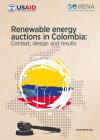

-
-
IRENA and USAID (2021), Renewable energy auctions in Colombia: Context, design and results, International Renewable Energy Agency, Abu Dhabi
Copied
/-/media/Files/IRENA/Agency/Publication/2021/March/IRENA_auctions_in_Colombia_2021.pdf
Copied
Renewable energy auctions in Colombia: Context, design and results
Newsletter
Renewable energy auctions in Colombia were designed to complement the country’s electricity market mechanisms, which were insufficient to attract non-hydro renewable energy development on a large scale. They now provide Colombia with opportunities to diversify power supply and increase the resilience of the power sector, while also fostering investor confidence.
The first auction, in February 2019, assigned bids between buyers and sellers, but did not award any contracts. Participation rates were promising, however, leading authorities to accelerate discussions on holding a second auction. Following modifications in the four categories of IRENA’s auction design framework – auction demand; qualification requirements and documentation; winner selection criteria; and risk allocation – in October 2019, the second auction successfully awarded contracts.
This report by the International Renewable Energy Agency (IRENA) and the United States Agency for International Development (USAID) analyses the changes in design between the two auctions, as well as their price outcomes and the factors affecting those prices.
Among the findings:
- The second auction secured around 1.3 gigawatts (GW) of new wind and solar photovoltaic (PV) capacity, which is scheduled to become operational by 2022.
- At USD 28.40/megawatt hour (MWh) for solar PV and USD 27.70/MWh for wind, Colombia's weighted average prices were significantly lower than the global average for auctions in 2018 – solar PV was half the global average of USD 56/MWh, while wind prices were 42% lower than the global average of USD 48/MWh.
- The low prices may be attributed to Colombia's rich wind and solar resources; the availability of different fiscal incentives for renewables; and growing investor confidence in auctions and their enabling frameworks.
- The auction's power purchase agreement (PPA) contract price includes the CERE payment, which is paid back to generators to reward them for the reliability or ‘firmness’ of their supply to the national system. Bids in renewable energy auctions can therefore be influenced by parallel participation in ‘firm’ energy auctions, because generators may retain the CERE payment in their renewable auction bid (valued at USD 17.88/MWh in October 2019) and consider it additional PPA revenue. Hence, the lowest wind bids in the auction came from three projects that were also awarded through firm energy auctions.
- Systematic auctions that involve a commitment to a longer-term schedule may attract a larger number of bidders, leading to increased penetration of non-hydro renewable energy.
- Beyond price discovery, auctions offer the potential to engage communities, contribute to subnational development, foster the development of local industries and create jobs – in this case, in the historically marginalised and energy-poor La Guajira region of Colombia.




